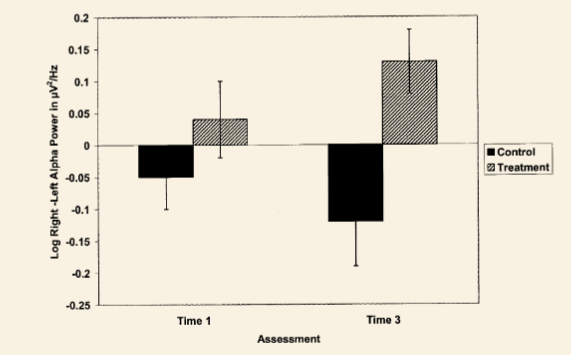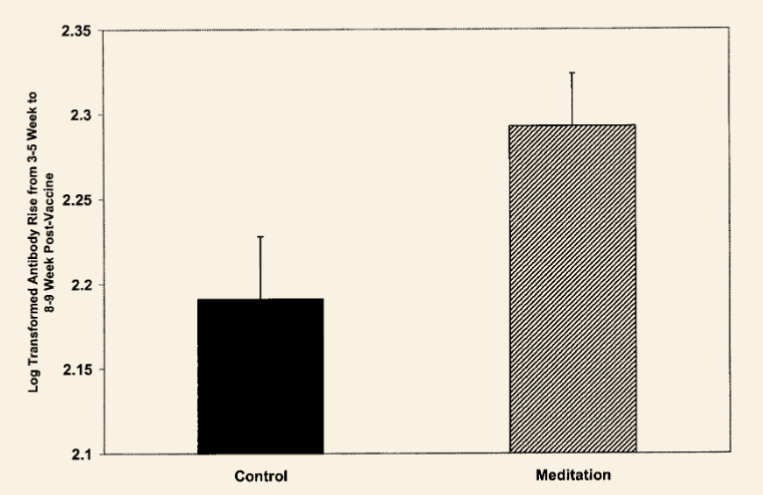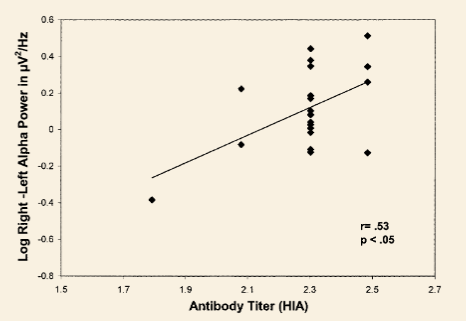Background Information
Meditatative practices – under what has become known as integrative medicine – are becoming more commonly used in medical settings for outpatients presenting with things like chronic stress/disease and pain-related disorders. The question of the biological mechanisms by which meditation can drive somatic, cognitive and emotional processes is only becoming more important.
Most studies up to this point have focused primarily on the changes “inside” of an individual meditation session, by comparing a meditator’s state before and during meditation. This study aims to put meditation in a wider work context by tracking changes when people are given an extended (8-week) training, and follows up with them in the months thereafter to begin to understand the more enduring changes that meditation can provide.
What They Did
This study involved recruiting 48 right-handed employees from a biotechnology corporation in Madison, Wisconsin. These individuals were chosen to participate in a randomized controlled study to examine the effects of an 8-week
Mindfulness
Mindfulness is the psychological process of purposely bringing one’s attention to experiences occurring in the present moment without judgment. It involves maintaining awareness of thoughts, feelings, bodily sensations, and surrounding environment with an attitude of curiosity and acceptance. In meditation contexts, mindfulness practices typically involve focusing attention on the breath or body sensations as anchors to the present moment while acknowledging and releasing distracting thoughts.
More on Wikipedia
View in glossary
-Based Stress Reduction (
MBSR
Mindfulness-Based Stress Reduction (MBSR) is a program designed to help individuals cope with stress, pain, and illness. Developed by Jon Kabat-Zinn in the 1970s, it combines meditation and yoga to promote awareness and stress management. The eight-week program teaches participants to focus on the present moment non-judgmentally, enhancing their ability to manage difficulties.
More on Wikipedia
View in glossary
) program applied in a work environment. Out of the initial participants, 41 completed some of the measures for at least two of the assessment points.
Before the start of the study, an initial laboratory evaluation was conducted for all participants without revealing their future group assignment. Following this preliminary assessment, subjects were randomly assigned to either the meditation group, consisting of 25 participants (19 females), or a wait-list control group, consisting of 16 participants (10 females). This assignment was done at a ratio of approximately 3:2.
Participants underwent a series of assessments at three different time points: before the start of the MBSR program (Time 1), immediately after the program (Time 2), and four months after the program (Time 3). At eaxch time, the participants underwent an
EEG
An electroencephalogram (EEG) is a recording of brain activity. During this painless test, small sensors are attached to the scalp to pick up the electrical signals produced by the brain.
More on Wikipedia
View in glossary
scan while being presented with emotional stimuli.
Additionally, all participants received a flu vaccine at the Time 2, and the authors measured the immune response to the vaccine from blood antibody levels.
Upon completion of the last assessment, participants in the wait-list control group were offered the same 8-week MBSR training provided to the meditation group, ensuring that all participants eventually had the opportunity to receive the intervention. This approach not only facilitated the ethical conduct of the study by offering all participants access to the potentially beneficial meditation training but also allowed for a controlled comparison between those who had immediately undergone the MBSR program and those who were initially placed on a wait list.
One Big Result
The first major finding of this study was that the 8-week MBSR course let to measurable changes in brain function when the subjects were presented with emotional stimuli. One brain measurement that has been associated with positive emotions is asymmetry of brain activation. From a recent review of the literature:
Formation and regulation of happiness and positive emotions are associated with significant reductions in activity in the right prefrontal cortex […], as well as with increased activity in the left prefrontal regions
The authors measured this asymmetry by taking the difference in the amount of activity in the right and left hemispheres in the brain, as shown in this figure:

Furthermore, the authors looked at the immune response of the subjects to a flu vaccine, as depicted here:

The authors note that:
To our knowledge, this is the first demonstration of a reliable effect of meditation on an in vivo measure of immune function. The finding may reflect a relatively more rapid peak rise in antibody titers among the meditators compared with the controls
This study is primarily observational, but the autors do note
Recent studies have established that greater relative leftsided anterior activation at baseline is associated with enhanced immune function
And also point to other research on HIV-positive men, where relaxation and stress management procedures increased immune function:
Recent research indicates that relaxation and stress management procedures increase T-cytotoxic/suppressor (CD3+CD) lymphocytes in HIV-infected me
Further evidence that the driving factor is meditation comes from this chart, which shows the correlation between the brain activiation asymmetries and the flu vaccine response:

Overall the authors take these findings to mean that:
a short training program in mindfulness meditation (MBSR) has demonstrable effects on brain and immune function and underscores the need for additional research on the biological consequences of this intervention
I, personally, find this result to be very exciting. First, this study was performed on untrained meditators with only an 8-week course in meditation. Indicating that meditation benefits are available to all, not just those who dedicate their lives to it. Second, the study shows that meditation can have a measurable effects in the physiological world (in this case, the immune system), and that its impacts can be felt outside of the brain.
Miscellaneous Interesting Takeaways
It Doesn’t Take Much
In other papers I reviewed on this site, subjects who were experienced meditators (to the tune of tens of thousands of hours), had striking differences in their brain activity compared to non-meditators for both meditations leading to
Jhana
Jhana refers to states of deep concentration or meditative absorption in Buddhist practice, achieved through intense focus and mindfulness. These states represent progressive levels of mental and emotional calm, clarity, and bliss, cultivated through the practice of meditation, leading to profound insight and enlightenment.
More on Wikipedia
View in glossary
(Hagerty et al. 2013) and meditation on the
Brahmavihārās
Brahma Vihara meditation, also known as the Four Immeasurables, involves cultivating four qualities: loving-kindness (metta), compassion (karuna), empathetic joy (mudita), and equanimity (upekkha). It aims to develop a state of unconditional love, compassion towards suffering, joy in the happiness of others, and a balanced mind in all situations.
More on Wikipedia
View in glossary
(Lutz et al. 2004) meditations.
This study, however, found that even a short training program in mindfulness meditation (MBSR) has demonstrable effects on brain and immune function. This suggests that the benefits of meditation are accessible to everyone, not just those who have dedicated their lives to the practice.
Happiness Is Trainable
This paper is part of a growing body of studies that indicate the brain is trainable, and that tendency towards positive emotions is a trainable skill. This is a hopeful message for those who struggle with negative emotions.
Citation
Davidson, R. J., Kabat-Zinn, J., Schumacher, J., Rosenkranz, M., Muller, D., Santorelli, S. F., Urbanowski, F., Harrington, A., Bonus, K., & Sheridan, J. F. (2003). Alterations in Brain and Immune Function Produced by Mindfulness Meditation. In Psychosomatic Medicine (Vol. 65, Issue 4, pp. 564–570). Ovid Technologies (Wolters Kluwer Health). 10.1097/01.psy.0000077505.67574.e3